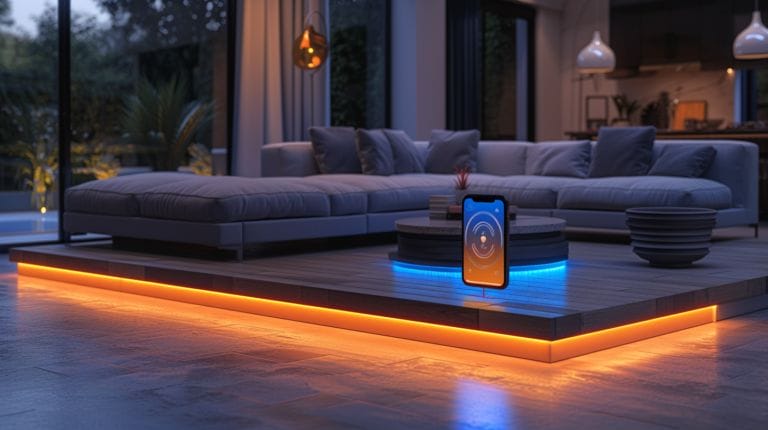Can LED Lights Hurt Your Eyes? Learning LED Lights’ Impact
As we bask in the glow of screens and rooms lit with Light Emitting Diodes (LEDs), discussions ensue about the unseen negative effects these lights have on our eyes. Celebrated for energy efficiency, yet with potential costs to our vision, the debate around the safety of blue light exposure continues.
So, can LED lights hurt your eyes? Let’s shed light on the truth behind LED lights, unraveling the science without drowning in technical jargon. Discover how to keep your eyes healthy in a world awash with artificial light.
Key Takeaways
- Prolonged exposure to LED lights’ blue light can damage the retina and cause eye strain.
- Using blue light filters and following the 20-20-20 rule can protect eyes from LED light exposure.
- Not all artificial lighting affects eye health equally, with LEDs posing specific risks due to blue light.
- Innovations in LED technology, such as phosphor coating, aim to enhance eye safety while maintaining energy efficiency and versatility from smartphones to indoor lighting.
Understanding LED Lights: The Newer, Energy-Efficient Light Source

LED lights, marking a significant advancement in light-emitting technology, are fast becoming the go-to choice for energy-efficient, white light illumination. The shift towards these luminaries promises to reduce energy bills and provide a sustainable alternative in lighting solutions. With the ability to transform electricity directly into light without excessive heat, LED lights are not only cost-effective but also cooler, making them ideal for various settings.
We’re drawn to LED lights for their unparalleled efficiency. Utilizing the principle of producing light when an electric current is passed, LEDs, including the ones in smartphones, offer a marked reduction in energy consumption compared to incandescent or fluorescent lights. This efficiency positions LEDs, particularly when phosphor coating is applied, as the preferred light source for those seeking innovative and eco-friendly lighting options.
Moreover, from red light to LED blue light, LEDs offer astounding variety. From ambient to task lighting, from indoor settings to smartphones, there’s an LED solution for virtually every application, considering LED lights have become so integral in modern living. The versatility of LEDs means adopting this technology doesn’t force a compromise on aesthetics or functionality.
The Truth About Blue Light: Is the Blue LED Light Bad for Your Eyes?

As we increasingly rely on LED devices, it’s crucial to consider how the blue light they emit might affect our eyes. The impact of LED blue light, especially high energy light from smartphones and indoor LED lights, on our eyes is a topic ripe with innovation and debate.
Blue light naturally emanates from the sun, regulating our sleep and wake cycles. However, the blue light from LED lights is more intense and comes from artificial sources. This difference raises concerns about prolonged exposure, especially during nighttime.
When high energy LED blue light enters our eyes, it reaches the retina, the part of the eye sensitive to light. The energy emitted by blue LED light is higher than other light sources, suggesting a possibility of retina damage over time.
The extent of eye damage that could be caused by blue light from LED-equipped light bulbs is subject to ongoing debate among scientists and health professionals. Some studies suggest potential harm, while others find minimal risk. Nevertheless, the need for more targeted research to understand the long-term effects is clear.
Potential Effects of LED Lights on Your Eyes: Are LED Lights Safe?

As we delve into the safety of LED lights, it’s essential to explore how prolonged exposure might affect our eyes, considering common complaints, the phenomenon of digital eye strain, and the latest research findings on potential long-term impacts.
- Eye strain and potential macular degeneration after long periods under indoor LED lighting or in front of screens is a common experience. Symptoms such as dryness, irritation, and difficulty focusing point to digital eye strain, emphasizing the need for a closer look at our interaction with LED devices.
- The primary concern with the use of LED lights or light-emitting bulbs centers around their blue light. Research suggests that prolonged exposure to blue light, often emitted by electronic devices, could potentially lead to retinal damage and eye disease. Blue light penetrates more deeply than UV light, posing a risk to our retinal cells. This insight has ignited debates on whether our increasing exposure to LEDs could have long-lasting effects on our eye health.
- Moreover, blue light’s impact on our circadian rhythm is another area of concern. It can disrupt our natural sleep patterns, leading to sleep disturbances. Given the vital role of sleep in overall health, including eye health, this disruption isn’t something we can overlook.
How to Protect Our Eyes Naturally from LED Lights and Blue Light Exposure

To safeguard our eyes from the potential hazards of LED lights and blue light exposure, we must consider integrating specific dietary and lifestyle changes. Understanding the role of diet and lifestyle in eye health is crucial in minimizing the risks associated with prolonged exposure to blue light and LED lights.
Here are four essential strategies:
- Incorporate Eye-Healthy Nutrients: Boost your intake of foods rich in omega-3 fatty acids, lutein, zeaxanthin, and vitamins C and E. These nutrients are known for their protective properties against blue light exposure and can be found in leafy greens, fish, eggs, and nuts.
- Use Blue Light Filters: Equip your tablets and digital devices with blue light filters to reduce exposure, especially during nighttime.
- Adopt the 20-20-20 Rule: Every 20 minutes, take a 20-second break to look at something 20 feet away. This practice helps reduce eye strain and discomfort from prolonged screen time.
- Explore Eye-Friendly Lighting Options: Replace harsh LED lights with eye-friendly white light alternatives that offer a broader spectrum of light.
Addressing Common Misconceptions: Are All Lights Bad for Your Eyes?

Dispelling myths about artificial lighting is crucial. While LED lights are prevalent, it’s essential to understand that not all artificial light sources are created equal, nor do they have the same impact on our eye health.
The narrative that all artificial lighting is bad for our eyes lacks nuance. LED lights, when used correctly and with appropriate moderation, don’t pose a significant threat to our eye health. In fact, compared to older lighting technologies, LEDs often offer a safer alternative due to their lower emission of harmful ultraviolet (UV) light.
Research and expert opinions underscore the importance of context—such as the color temperature of LED lights, the duration of exposure, and whether the light is direct or diffused. Innovations in light-emitting diode (LED) technology continue to minimize potential adverse effects on eye health, making them a more eye-friendly option than many assume.
Conclusion
In conclusion, while LED lights offer energy efficiency and longevity, it’s essential to understand their impact on our eyes. The blue light emitted can be harmful, but not all lights pose the same risk.
We’ve learned ways to protect our eyes naturally, debunking the myth that all lights are detrimental. By being mindful of our exposure and taking simple protective measures, we can enjoy the benefits of LED lights without compromising our eye health.
Frequently Asked Questions
Do LED lights cause eye damage?
LED lights can cause eye damage if there is overexposure to high-energy blue light. This can lead to potential harm to the retina and may contribute to vision loss over time.
What is the impact of LED lights on your eyes?
LED lights emit a significant amount of blue light, which has a shorter wavelength and higher energy compared to other types of artificial light. Prolonged exposure to this light can lead to eye strain, discomfort, and potentially damage to the retina.
How do LED lights affect sleep patterns?
LED lights, particularly those with a high amount of blue light, can suppress the production of melatonin, a hormone that regulates sleep. Excessive exposure to such light, especially in the evening, can disrupt natural sleep patterns and lead to sleep disturbances.
How can I protect my eyes from LED light damage?
To protect your eyes from potential harm caused by LED lights, you can use LED bulbs with lower amounts of blue light, consider using warm white or yellow phosphor-coated LED lights, and limit exposure, especially before bedtime.
Are LED lights more harmful than other types of artificial light?
LED lights, particularly those with high blue-light emission, have been found to have a potentially greater impact on eye health compared to other types of artificial light, such as fluorescent bulbs. This is due to the specific wavelength and energy of the light emitted by LEDs.






